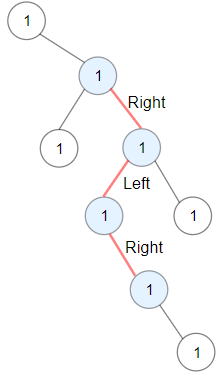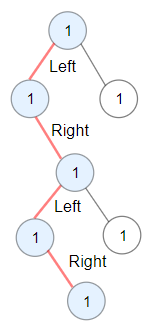You are given a binary tree in which each node contains an integer value.
Find the number of paths that sum to a given value.
The path does not need to start or end at the root or a leaf, but it must go downwards (traveling only from parent nodes to child nodes).
The tree has no more than 1,000 nodes and the values are in the range -1,000,000 to 1,000,000.
Example:
root = [10,5,-3,3,2,null,11,3,-2,null,1], sum = 8
10
/ \
5 -3
/ \ \
3 2 11
/ \ \
3 -2 1
Return 3. The paths that sum to 8 are:
1. 5 -> 3
2. 5 -> 2 -> 1
3. -3 -> 11
My answer is: basic idea to compute suffix sum of each path when node is being traversed. Thus complexity is O(n^2). Better solution is shown below, which is O(n).
/** * Definition for a binary tree node. * public class TreeNode { * int val; * TreeNode left; * TreeNode right; * TreeNode() {} * TreeNode(int val) { this.val = val; } * TreeNode(int val, TreeNode left, TreeNode right) { * this.val = val; * this.left = left; * this.right = right; * } * } */ class Solution { private int pathFound = 0; private Map<TreeNode, Integer> nodesSum = new HashMap<TreeNode, Integer>(); public int pathSum(TreeNode root, int sum) { List<List<Integer>> expectedValuesInPaths = new ArrayList<List<Integer>>(); List<TreeNode> currentNodes = new ArrayList<TreeNode>(); helper(root, sum, currentNodes); return pathFound; } private void helper(TreeNode node, int sum, List<TreeNode> currentNodesInPath) { if (node == null) { return; } int paths = getSuffixPaths(currentNodesInPath, node, sum); pathFound += paths; currentNodesInPath.add(node); helper(node.left, sum, currentNodesInPath); helper(node.right, sum, currentNodesInPath); // remove last added node currentNodesInPath.remove(currentNodesInPath.size() - 1); } private int getSuffixPaths(List<TreeNode> previousNodes, TreeNode currentNode, int sum) { int paths = 0; List<Integer> nodeSums = new ArrayList<Integer>(); int currentSum = currentNode.val; // in case currentNode itself can be sufficient nodeSums.add(currentSum); if (currentSum == sum) { paths ++; } for (int i = previousNodes.size() - 1; i >= 0; i--) { TreeNode prevNode = previousNodes.get(i); currentSum += prevNode.val; nodeSums.add(currentSum); if (currentSum == sum) { paths ++; } } return paths; } }
Best O(n) solution: calculate prefix sum for path. On 1 path, (prefix sum on index j - prefix sum on index i) = sum[i:j]. Thus, if prefixSum == targetValue OR (prefixSum - targetValue) in prefixSumsMap.
1 2 3 4 5 6 7 8 9 10 11 12 13 14 15 16 17 18 19 | public int pathSum(TreeNode root, int sum) { HashMap<Integer, Integer> preSum = new HashMap(); preSum.put(0,1); return helper(root, 0, sum, preSum); } public int helper(TreeNode root, int currSum, int target, HashMap<Integer, Integer> preSum) { if (root == null) { return 0; } currSum += root.val; int res = preSum.getOrDefault(currSum - target, 0); preSum.put(currSum, preSum.getOrDefault(currSum, 0) + 1); res += helper(root.left, currSum, target, preSum) + helper(root.right, currSum, target, preSum); // remove current node's impact
preSum.put(currSum, preSum.get(currSum) - 1);
return res;
}
|

